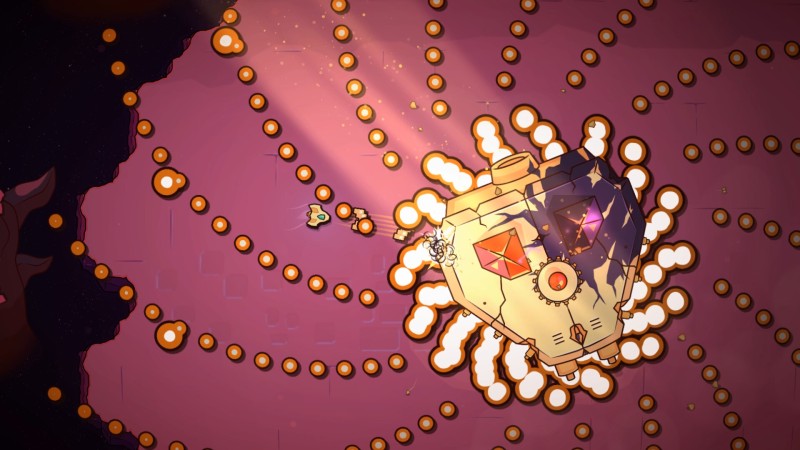Minishoot' Adventures Review – A Link Between Genres

Games inspired by The Legend of Zelda are common; after all, the long-running Nintendo franchise is among the most influential series in gaming history. Because of this, various games take the Zelda format and try to replicate it, but these homages often miss out on the magic that makes that series greater than the sum of its parts. This is particularly true in the indie space, with Zelda-inspired titles a dime a dozen, making it difficult to stand out from the crowd. Minishoot’ Adventures clearly draws inspiration from Zelda – specifically A Link to the Past – but by applying the formula to the twin-stick shooter bullet-hell genre, it elevates itself to the top of the field.
In a clever twist on the Zelda formula, Minishoot’ Adventures puts you in control of a small ship exploring a corrupted world. Navigating the map feels fantastic, thanks to fluid controls, an ever-growing repertoire of moves, and a crisp, beautiful art style. During the course of your adventure, the main thrust of the gameplay is rooted in the game’s compelling and finely-tuned twin-stick shooting. As you traverse from screen to screen, enemies spawn and create battle arenas. These opponents range from small ships with single-firing bullets to swarms of dive-bombing, armored menaces that leave a trail of projectiles each time they fly forward.
[embedded content]
As you enter each individual battle arena, you face escalating waves of enemies. Since each biome contains distinct baddies, and the arenas present unique combinations of adversaries, I eagerly anticipated each drawn-out battle – I often moved to the next area, hoping it would trap me in and begin spawning in waves of enemies. At its most hectic, the bullets fly at you in varying patterns and sizes from different angles on the screen, but more often than not, I found myself completely mesmerized by the alluring patterns I needed to navigate to avoid taking damage. One of the things I appreciate most about Minishoot’ Adventures is that while it ramps up the difficulty as you progress through the campaign, nothing ever felt unfair.
Even the bosses, who appear at the end of each dungeon and out in the world, present a stiff and engaging challenge but never made me question the fairness of the task at hand. Don’t get me wrong: I died plenty during the approximately 10-hour journey, but there were only a few encounters that took me down more than a couple of times. The only downside is that on rare occasions, the camera swings out so far that it can be difficult to be as precise in my avoidance of an incoming barrage of projectiles. However, most of the time, things are perfectly framed, giving me enough space to get a good view of my surroundings while still possessing the precision to navigate the cracks between the bullets.
Minishoot’ Adventures leverages the top-down Zelda formula to great effect. Exploring the handcrafted map for secrets kept me up late on multiple occasions. Each area flows naturally into the next, making it so I rarely got lost. Even the secret areas tucked behind walls and trees are easy enough to spot; on rare occasions, I would miss a visual cue for a secret or a puzzle solution, but it was always my own fault. There was never a time when I had to look up a solution or thought to myself, “How was I supposed to know to do that?” Everything in Minishoot’ Adventures’ world feels organic and rewarding.
Developer SoulGame Studio expertly encourages exploration through a plethora of upgrades; I loved taking on race challenges (which perfectly highlight the stellar movement mechanics), but the primary driver of my desire to explore was the extensive suite of upgrades. You gain experience for each enemy you defeat, as well as for finding caches of experience-granting red gems; each time you level up, you get a skill point that can be allocated to upgrade things like your damage, firing range, movement speed, and more. The upgrades you unlock through leveling are helpful, and if an encounter ever felt too tough, I knew I could go grind nearby spawn points to gain enough experience to bump up those skills.
However, the biggest improvements arrived through modules and stranded friends you discover through dungeon completion and exploration. The friends you rescue do things like heal you, improve your guns, and even open new areas. Meanwhile, the modules are scattered throughout the overworld map or for sale at hidden shops. These modules, like one that requires less experience to level up, one that tells you when a location on the map has more secrets, and one that grants you a small chance to take no damage when you get hit, are perhaps the most valuable items I found. Every corner of Minishoot’ Adventures provides you with rewards, which is why I kept saying, “Just one more area,” long after I told myself I needed to step away from my PC.
Thanks to its excellent utilization of well-worn Zelda-inspired conventions and enough unique twists to differentiate it from the pack, Minishoot’ Adventures delivers an outstanding bullet-hell experience with less frustration than most entries in the genre. I didn’t set out to 100 percent Minishoot’ Adventures, but by the time I reached the end of the the story, I had experienced everything the game has to offer, a testament to how enamored I am with this fun, twin-stick title. Minishoot’ Adventures bridges the gaps between disparate genres with outstanding gameplay and thoughtful level design to deliver one of the best games I’ve played all year.


Comments are closed.